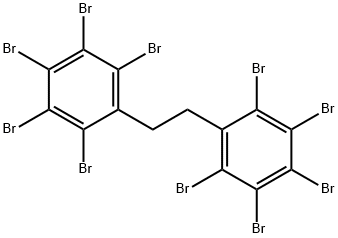|
|
| | Decabromodiphenyl Ethane Basic information |
| Product Name: | Decabromodiphenyl Ethane | | Synonyms: | 1,2-Bis(perbroMophenyl)ethane;DECABROMODIPHENYL ETHYL;2,2',3,3',4,4',5,5',6,6'-DECABROMOBIBENZYL;1,1'-(ethane-1,2-diyl)bis(pentabromobenzene);1,2-BIS(PENTABROMOPHENYL) ETHANE;1,2-BIS(2,3,4,5,6-PENTABROMOPHENYL)ETHANE;SAYTEX(R) 8010 FLAME RETARDANT;DBDPE/RDT-3 | | CAS: | 84852-53-9 | | MF: | C14H4Br10 | | MW: | 971.22 | | EINECS: | 284-366-9 | | Product Categories: | Flame retardant series | | Mol File: | 84852-53-9.mol |  |
| | Decabromodiphenyl Ethane Chemical Properties |
| Melting point | 345°C | | Boiling point | 676.2±50.0 °C(Predicted) | | density | 2.816±0.06 g/cm3(Predicted) | | storage temp. | Sealed in dry,Room Temperature | | solubility | Dioxane (Very Slightly, Heated) | | form | Solid | | color | Off-White to Pale Beige | | InChI | InChI=1S/C14H4Br10/c15-5-3(6(16)10(20)13(23)9(5)19)1-2-4-7(17)11(21)14(24)12(22)8(4)18/h1-2H2 | | InChIKey | BZQKBFHEWDPQHD-UHFFFAOYSA-N | | SMILES | C(C1=C(Br)C(Br)=C(Br)C(Br)=C1Br)CC1=C(Br)C(Br)=C(Br)C(Br)=C1Br | | LogP | 3.55 at 25℃ | | CAS DataBase Reference | 84852-53-9(CAS DataBase Reference) | | EPA Substance Registry System | Benzene, 1,1'-(1,2-ethanediyl)bis[2,3,4,5,6-pentabromo- (84852-53-9) |
| | Decabromodiphenyl Ethane Usage And Synthesis |
| Chemical Properties | Decabromodiphenyl ethane is a powder with a high molecular weight, very low water solubility, and low lipophilicity (as indicated by log Kow). The particles are <15 μm in diameter, and thus, this substance is expected to be respirable after inhalation exposure. | | Physical properties | White or pale yellow powder. Slightly soluble in alcohol, ether, almost insoluble in water. | | Uses | Decabromodiphenyl ethane (DBDPE) is a brominated flame retardant used as an additive in a variety of polymer and textile applications. In polymeric applications, such as high impact polystyrene,DBDPE is compounded or blended into the resin. The resulting DBDPE containing plastics are then converted to finished products by, for example, injection molding. For textile applications, DBDPE is blended with various latices and applied as a back coating to the textile. | | Preparation | Diphenyl ethane (DPE) was synthesized by using benzene and dichloroethane as raw materials and AlC3 as catalyst, and then DPE was brominated and aged to obtain decabromodiphenyl ethane. | | Application | Decabromodiphenyl ethane, a widely used new brominated flame retardant, is added into flammable materials to achieve fire retardation. It used in thermoplastics, thermosets, textiles and coatings that inhibit or resist the spread of fire. | | Environmental Fate | Decabromodiphenyl ethane’s physicochemical properties suggest that it will partition predominantly in sediment and soil through binding to the organic fraction of particulate matter. In the EA environmental risk assessment, it concluded that DBDPEthane is unlikely to rapidly undergo photodegradation in the presence of hydroxyl radicals, it is not readily biodegradable in the aquatic environment under aerobic conditions, and it is not hydrolysable (no hydrolysable groups) (Dungey and Akintoye, 2007). No data were available to assess the biodegradation under anaerobic conditions [e.g., wastewater treatment plants (WWTPs) or in sediments]; the EA noted the possibility of reductive debromination under these conditions.
The potential for DBDPEthane to bioconcentrate was evaluated in an 8-week fish bioconcentration study (Dungey and Akintoye, 2007). When fish were exposed to DBDPEthane at concentrations of 0.5 and 0.05mg/l, the respective fish bioconcentration factors (BCFs) were <2.5 and <25 l/kg wet weight (ww), respectively. Since the water concentrations used exceeded DBDPEthane’s water solubility, the dissolved concentration was unknown. The EA appropriately considered this study invalid. No additional BCF studies are available; however, based on the physicochemical properties, lowtoxicity in acute and repeated dose mammalian, aquatic, and terrestrial studies, it is unlikely that DBDPEthane will bioaccumulate. |
| | Decabromodiphenyl Ethane Preparation Products And Raw materials |
|